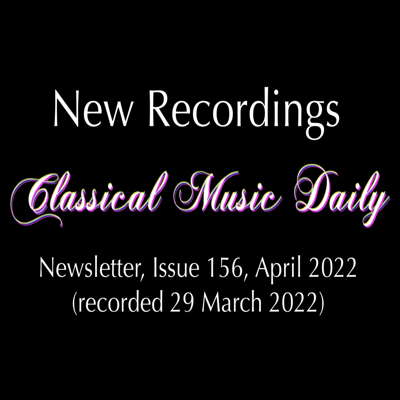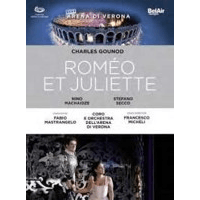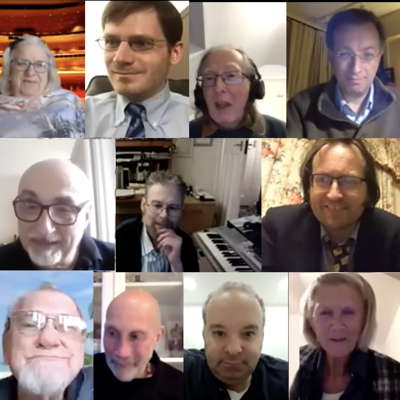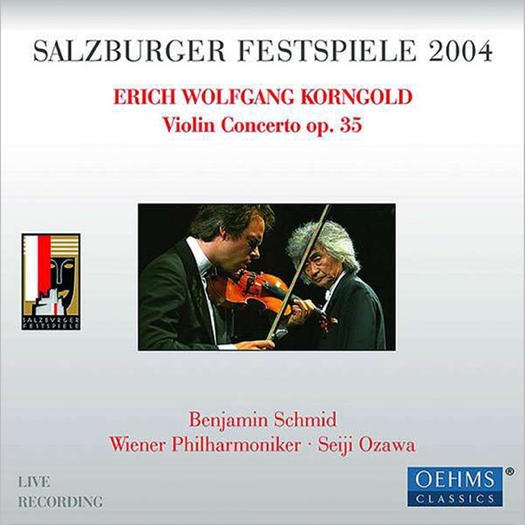 VIDEO PODCAST: New Recordings - Find out about Adrian Williams, Andriy Lehki, African Pianism, Heinrich Schütz and Walter Arlen, and meet Stephen Sutton of Divine Art Recordings, conductor Kenneth Woods, composer Graham Williams and others.
VIDEO PODCAST: New Recordings - Find out about Adrian Williams, Andriy Lehki, African Pianism, Heinrich Schütz and Walter Arlen, and meet Stephen Sutton of Divine Art Recordings, conductor Kenneth Woods, composer Graham Williams and others.
 SPONSORED: DVD Spotlight. Olympic Scale - Charles Gounod's Roméo et Juliette, reviewed by Robert Anderson.
SPONSORED: DVD Spotlight. Olympic Scale - Charles Gounod's Roméo et Juliette, reviewed by Robert Anderson.
All sponsored features >>
 VIDEO PODCAST: James Ross and Eric Fraad discuss Streaming, Downloads and CDs with Maria Nockin, Mary Mogil, David Arditti, Gerald Fenech, John Daleiden, John Dante Prevedini, Lucas Ball and Stephen Francis Vasta.
VIDEO PODCAST: James Ross and Eric Fraad discuss Streaming, Downloads and CDs with Maria Nockin, Mary Mogil, David Arditti, Gerald Fenech, John Daleiden, John Dante Prevedini, Lucas Ball and Stephen Francis Vasta.


Two Fine Violinists
STEPHEN FRANCIS VASTA listens to
music by Erich Wolfgang Korngold
'Even the Violin Concerto ends with a downward chordal scale that 'resolves' to a dissonance, "à la" Charles Ives!'
music by Erich Wolfgang Korngold
'Even the Violin Concerto ends with a downward chordal scale that 'resolves' to a dissonance, "à la" Charles Ives!'
The Salzburg Festival of 2004 devoted a large chunk of its programming to the concert music of Erich Wolfgang Korngold. The performance of the opera Die tote Stadt, available on another OEHMS issue, was no doubt the festival's centerpiece, but room was also found to program a variety of his purely instrumental works.
Korngold made his name in Hollywood, composing big, Romantic scores for the movies — which, unfortunately, led the would-be cognoscenti to dismiss him as a serious composer. In the 1970s, RCA's re-recorded selections from his scores, as well as those of Newman, Rosza, and others, in its 'Classic Film Scores' series; its success led the company to record Korngold's Symphony in F-sharp. Shortly thereafter, EMI followed suit with a (somewhat overproduced) recording of this Violin Concerto and other orchestral pieces. The music has gained some traction on record, but, save for the concerto, you don't see it actually turning up on concert programs.
The composer's musical idiom, which remains consistent through the changes of genre and performing forces, somewhat subverts expectations. Certainly, the basic harmonic language remains firmly late-Romantic, with the tuttis of the Violin Concerto hinting at the grandeur of the film scores. In the themes, however — particularly in the chamber works — gently angular dissonances hover above the rich sonorities, hinting at a Bergian Expressionism. Since Korngold had no use for the Second Viennese School or for atonality in general, these sounds presumably reflect other influences — the Berlin Weill, perhaps, by way of Hindemith.
In the Suite, a solo piano episode at 2.56 of the Rondo-Finale is dark and anguished; earlier, the start of the same score's Groteske, a Shostakovich-style burlesque, is surprisingly pointillistic, its isolated piano plinks only gradually coalescing into a recognizable theme.
Listen — Korngold: Groteske (Suite Op 23)
(track 11, 0:00–0:56) © 2004, 2018 OehmsClassics Musikproduktion GmbH :
The Garden Scene of the Much Ado About Nothing incidental music suggests a harmonically advanced Mendelssohn Song Without Words.
Listen — Korngold: Gartenszene (Much Ado About Nothing)
(track 7, 0:01–0:45) © 2004, 2018 OehmsClassics Musikproduktion GmbH :
Even the Violin Concerto ends with a downward chordal scale that 'resolves' to a dissonance, à la Charles Ives!
The program showcases not just the composer but two fine violinists, each featured in two works. Benjamin Schmid's firm-bowed playing in the Concerto and Suite is gratifying. He renders the Concerto's virtuosic writing with a particular flair — the little Brahms- and Bruch-like figurations are properly 'rhapsodic', and upward leaps are both full and accurate — but is equally attuned to the wistful, spacious central Romance.
Listen — Korngold: Romance (Violin Concerto in D)
(track 2, 6:03–6:54) © 2004, 2018 OehmsClassics Musikproduktion GmbH :
The Suite is effectively a standard 'piano quartet', but for left-hand piano; here Schmid is primus inter pares, but shines nonetheless in the expressive, lyrical melodies of the bittersweet Walzer, which doesn't feel like one, and the Lied.
David Frühwirth is the soloist in the two violin-and-piano scores. He, too, is technically adept — the upward leap near the end of Heilane's song is breathtakingly pure — but is even more impressive in such passages as the aria's deep, intense opening.
Listen — Korngold: Gesang der Heliane Op 20
(track 4, 0:02–0:39) © 2004, 2018 OehmsClassics Musikproduktion GmbH :
In the Much Ado pieces, he's equally poised in the lyrical phrases and in some quirky, playful moments suggesting late Richard Strauss; the recapitulation of the Garden Scene is passionate and impetuous. The pianist, Henri Sigfridson, seconds Frühwirth with firm tonal depth and, at the end of the Much Ado Garden Scene, sparkling runs.
Seiji Ozawa presides over the Vienna Philharmonic in the concerto. He has a good basic feeling for the music's broad singing themes and for the scherzando spirit of the Finale's opening. The interplay of the lighter textures with the soloist is deft and effective; the busier ones in the Finale are well organized. His soft-edged, restrained way with the tuttis, allowing them some expansion while avoiding the 'Hollywood' curse, is initially welcome. The sonorities, however, never achieve the luminous transparency of, say, Ozawa's studio Mahler Eighth (Philips); the effect is pleasant but strangely neutral, as on his old recordings of two Griffes tone-poems (New World). The orchestra responds well enough, though, in the Finale, it has trouble keeping up in the home stretch.
Listen — Korngold: Finale (Violin Concerto in D)
(track 3, 6:11–7:11) © 2004, 2018 OehmsClassics Musikproduktion GmbH :
Better versions of the Concerto are available — that by Anne-Sophie Mutter (DG) is particularly high-powered — but I was pleased to hear all the chamber music.
New York, USA

CD INFORMATION: SALZBURG FESTIVAL 2004 - KORNGOLD: VIOLIN CONCERTO

